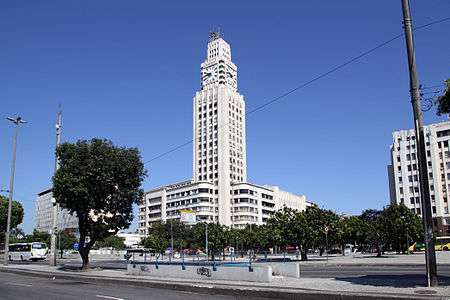SuperVia
 | |
 | |
| Overview | |
|---|---|
| Locale | Greater Rio de Janeiro |
| Transit type | Commuter rail |
| Number of lines | 8 working, 1 in project. |
| Number of stations | 100 (2 under construction) |
| Daily ridership | 620,000 (2014)[1] |
| Operation | |
| Began operation | 1 November 1998 |
| Operator(s) | SuperVia Concessionária de Transportes Ferroviários |
| Technical | |
| System length | 252 km (156.5 mi) |
| Track gauge | 1,600 mm (5 ft 3 in) |
| Electrification | (?) V Catenary |
SuperVia Trens Urbanos (Portuguese pronunciation: [ˌsupeʁˈvi.ɐ tɾẽˑzuʁˈbɐ̃nuⁱʃ], meaning SuperVia Urban Trains) is a Brazilian train operator founded in Rio de Janeiro in November 1998. It carries around 152 million passengers[2] a year on a railroad network comprising 100 stations in 12 cities: Rio de Janeiro, Duque de Caxias, Guapimirim, Nova Iguaçu, Nilópolis, Mesquita, Queimados, São João de Meriti, Belford Roxo, Japeri, Paracambi and Magé.
The baggage areas of SuperVia trains were an adaptation of the original design to fit the Brazilian reality. A Brazilian study found that the average passenger carries a weight of 7 kg in backpacks, shopping bags or briefcases on their daily commute.[3]
History
In 1998, a concession agreement commenced, which established the concessionaire's investment commitments (SuperVia) and grantor (State). Thus, it was possible to realise savings for the state coffers of more than US$1.6 billion, a figure corresponding to the subsidies that the state failed to spend with the operation of the system in the period 1998/2009.
The result of these investments can be demonstrated by the increased number of passengers carried and the significant improvement in compliance with the scheduling of trains, which are monitored on an ongoing basis by the government, through the regulatory agency.
In 1998, before the grant, 145,000 passengers were transported per day, with a punctuality of less than 30%. In 2009, over 510,000 passengers were transported per day, with an average punctuality of 90%, the highest rate ever recorded in the history of the system.[4]
Modernization

With the arrival of 30 new trains in 2011, 14 previous SuperVia train configurations will be withdrawn from circulation. Capable of carrying 1,300 passengers, the new trains have several technical advantages, such as: alternating current traction motors, air conditioning with automatic temperature control, automatic coupling system, door system with detection of obstruction, electronic billboards and onboard displays, sound equipment, security cameras, lubrication system friezes, intercom and emergency signaling devices in accordance with the accessibility standard (NBR 14021).
Trains will also have cameras on the sides (mirror type), which allows monitoring by the driver of any platform without having to move away from the command post in the cabin. The color blue will be used (which is the color of the state and also a color of SuperVia). Made of fiber, the seats have a padded backrest in synthetic fabric. There are eight seats of a different color on each car and in the engine cars, there are special spaces for wheelchair users. And centers located in the fore sections of the cars, serves to transmit information to passengers. Four cameras will be installed in each car, allowing the driver to have visual surveillance of any emergency request. Four LCD televisions will be installed, with the goal of enabling business partnerships and educational and government institutions.[5]
Lines
.jpg)
| Line | Terminals |
|---|---|
| Deodoro | Central do Brasil ↔ Deodoro |
| Santa Cruz | Central do Brasil ↔ Santa Cruz |
| Japeri | Central do Brasil ↔ Japeri |
| Paracambi | Japeri ↔ Paracambi |
| Belford Roxo | Central do Brasil ↔ Belford Roxo |
| Saracuruna | Central do Brasil ↔ Saracuruna |
| Vila Inhomirim | Saracuruna ↔ Vila Inhomirim |
| Guapimirim | Saracuruna ↔ Guapimirim |
Special Services
| Line | Terminals |
| Campo Grande | Central do Brasil ↔ Campo Grande |
| Bangu | Central do Brasil ↔ Bangu |
| Engenho de Dentro | Engenho de Dentro ↔ Japeri |
| Queimados | Central do Brasil ↔ Queimados |
| Nova Iguaçu | Central do Brasil ↔ Nova Iguaçu |
| Nilópolis | Central do Brasil ↔ Nilópolis |
| Belford Roxo | Central do Brasil ↔ Belford Roxo |
| Gramacho | Central do Brasil ↔ Gramacho |
Aerial tramway/cable car of the "Complexo do Alemão" slum


On 8 July 2011, SuperVia began operating the "Complexo do Alemão" slum cable car, the first mass transit aerial lift passenger system in Brazil. The cable car is integrated into the urban rail transport system and has six stations - "Bonsucesso", "Adeus", "Baiana", "Alemão", "Itararé/Alvorada" and "Palmeiras". The system consists of 152 gondolas, each of which can carry 10 passengers, eight seated and two standing, and is 3.5 km in length.
From the first station (Bonsucesso) to last (Palmeiras) takes 16 minutes. According to the law signed by Governor Sérgio Cabral, each resident is entitled to two free tickets per day (one-way and one back). The unit rate will cost $1.00.
| Line | Terminals |
| Teleférico A | Palmeiras - Bonsucesso |
See also
References
External links
| Wikimedia Commons has media related to SuperVia. |
